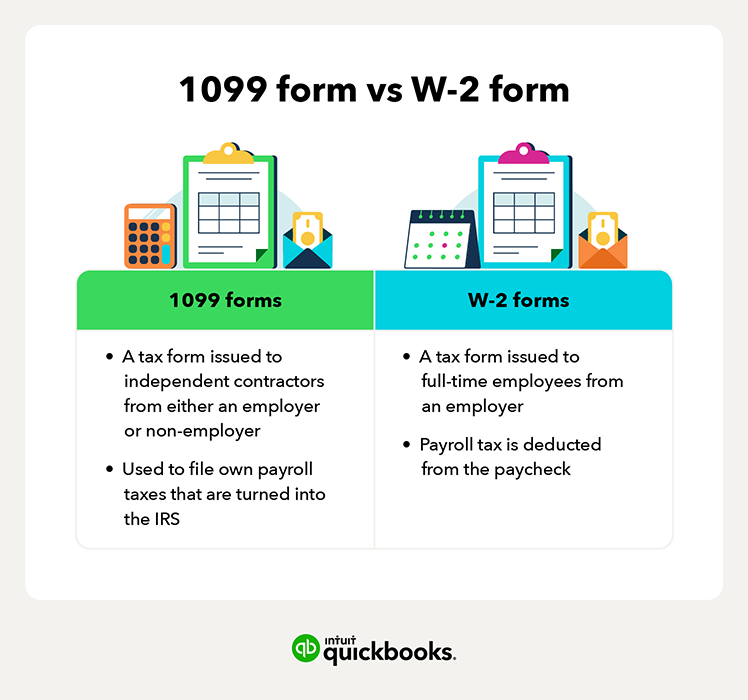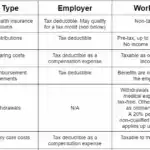When it comes to employment and taxation in the United States, understanding the differences between a W2 and a 1099 form is crucial for both employers and workers. These two documents serve distinct purposes and have different implications for tax obligations, benefits, and job security. Choosing between being a W2 employee or a 1099 contractor can significantly impact one’s financial and professional situation. This article aims to clarify the key differences between W2 and 1099, helping individuals determine which status is most beneficial for their specific circumstances and career goals.
Understanding the Difference Between W2 and 1099 Forms
When it comes to employment and taxation in the United States, two crucial forms come into play: the W2 and the 1099. These forms are essential for reporting income and taxes to the Internal Revenue Service (IRS). The main difference between a W2 and a 1099 lies in the employment status of the individual receiving the form. A W2 is issued to employees, while a 1099 is issued to independent contractors. Understanding the distinction between these two forms is vital for both employers and workers to navigate their tax obligations and benefits.
What is a W2 Form?
A W2 form, also known as the Wage and Tax Statement, is a document that employers are required to provide to their employees by January 31st of each year. It details the employee’s annual wages and the amount of taxes withheld from their paycheck. The information on the W2 form is used by employees to file their tax returns. Employers must also submit a copy of the W2 form to the IRS. The W2 form includes crucial information such as the employee’s gross income, federal income tax withheld, Social Security tax withheld, and Medicare tax withheld. It also reports other benefits like dependent care benefits and health savings account contributions.
What is a 1099 Form?
A 1099 form, specifically the 1099-MISC (Miscellaneous Income), is used to report various types of income that are not derived from employment, such as income earned by independent contractors. Businesses issue a 1099-MISC to independent contractors who have earned more than $600 in a calendar year. Unlike the W2, the 1099 form does not include taxes withheld because independent contractors are responsible for their own tax payments. The 1099-MISC form reports the nonemployee compensation and is used by independent contractors to report their income on their tax returns. It’s essential for independent contractors to accurately report their income and claim their business expenses to reduce their taxable income.
Key Differences Between W2 and 1099
The primary differences between a W2 and a 1099 form are based on the employment status and the tax implications.
| Feature | W2 | 1099 |
|---|---|---|
| Employment Status | Employee | Independent Contractor |
| Tax Withholding | Taxes are withheld by the employer | No taxes are withheld; contractor is responsible |
| Benefits | Eligible for employer benefits | Not eligible for employer benefits |
| Control Over Work | Employer has control over work and schedule | Contractor has control over work and schedule |
Tax Implications for W2 Employees
For W2 employees, the tax implications are relatively straightforward. Their employer withholds federal, state, and local taxes, as well as Social Security and Medicare taxes. Employees receive a W2 form at the end of the year, which they use to file their tax return. The taxes withheld are credited against their total tax liability.
Tax Implications for 1099 Independent Contractors
1099 independent contractors, on the other hand, are responsible for their own self-employment taxes, which include both the employee and employer portions of Social Security and Medicare taxes. They must also make estimated tax payments throughout the year to cover their tax liability. At the end of the year, they report their income and expenses on their tax return, and the net earnings from self-employment are subject to self-employment tax.
Choosing Between W2 and 1099: Which is Best?
The choice between being a W2 employee and a 1099 independent contractor depends on various factors, including job security, benefits, and tax obligations. W2 employees enjoy job security and benefits like health insurance and retirement plans but have less control over their work. 1099 contractors have more flexibility and control over their work but are responsible for their own benefits and taxes. Understanding the differences between these two statuses is crucial for making an informed decision that suits one’s financial and professional goals.
Is it better to be a 1099 or W-2 employee?

The answer to this question depends on several factors, including your personal financial goals, tax situation, and employment preferences. Being a 1099 employee, also known as an independent contractor, means that you are self-employed and responsible for your own benefits, taxes, and work schedule. On the other hand, being a W-2 employee means that you are employed by a company and receive a regular salary, benefits, and tax withholdings.
Tax Implications
When it comes to taxes, being a 1099 employee can have both advantages and disadvantages. As a 1099 employee, you are responsible for paying self-employment taxes, which include both the employee and employer portions of payroll taxes. However, you may also be able to deduct business expenses on your tax return, which can help reduce your taxable income. Here are some key tax implications to consider:
- You will need to file a Schedule C with the IRS to report your business income and expenses.
- You may be able to deduct business expenses, such as equipment, travel, and training, on your tax return.
- You will need to make estimated tax payments throughout the year to avoid penalties.
Benefits and Job Security
As a W-2 employee, you typically receive a range of benefits, including health insurance, paid time off, and retirement plans. You also have more job security, as you are entitled to certain protections under employment law. In contrast, 1099 employees are responsible for providing their own benefits and may not have the same level of job security. Here are some key differences to consider:
- W-2 employees typically receive health insurance and other benefits, while 1099 employees do not.
- 1099 employees may have more flexibility in their work schedule, but may also be required to work on a project-by-project basis.
- W-2 employees are entitled to certain protections under employment law, such as anti-discrimination laws and workers’ compensation.
Flexibility and Autonomy
One of the main advantages of being a 1099 employee is the flexibility and autonomy it provides. As a 1099 employee, you are free to choose your own work schedule and projects, and can work with multiple clients or businesses. However, this also means that you will be responsible for your own business development and client acquisition. Here are some key benefits to consider:
- You have the freedom to choose your own work schedule and projects.
- You can work with multiple clients or businesses, which can help diversify your income.
- You will need to be proactive in marketing yourself and finding new clients to sustain your business.
How much is $35 an hour on a 1099?

To understand how much $35 an hour is on a 1099, we need to consider several factors including the number of hours worked, the tax implications, and other expenses associated with being a 1099 worker. A 1099 worker is considered self-employed and is responsible for their own taxes, which includes both the employee and employer portion of payroll taxes.
Calculating Annual Income
When calculating the annual income from an hourly wage of $35 on a 1099, the first step is to determine how many hours are worked in a year. Assuming a full-time schedule of 40 hours per week and 52 weeks per year, the total hours worked would be 2,080. Thus, the annual income before taxes would be $35 2,080 = $72,800.
Here are key factors to consider when calculating annual income:
- The number of hours worked per week and the number of weeks worked per year significantly impact annual income.
- Tax deductions and other expenses can reduce the take-home pay.
- Business expenses related to the work can be deducted from the taxable income.
Tax Implications for 1099 Workers
As a 1099 worker, the individual is responsible for their own taxes, including self-employment tax, which covers both the employee and employer portion of payroll taxes. The self-employment tax rate is 15.3% of net earnings from self-employment, which includes income from 1099 work.
Here are some tax implications to consider:
- Self-employment tax is typically 15.3% of net earnings from self-employment.
- Income tax on 1099 income varies based on the individual’s tax bracket and other income.
- Business expense deductions can reduce taxable income.
Take-Home Pay Considerations
The take-home pay for a 1099 worker earning $35 an hour will be less than $72,800 due to taxes and other expenses. To estimate take-home pay, one must consider both income tax and self-employment tax.
Here are factors that affect take-home pay:
- Tax withholding is not automatically deducted; 1099 workers must make estimated tax payments.
- Business expenses can reduce taxable income, thus potentially lowering taxes owed.
- Retirement savings options, such as a SEP-IRA, can provide tax benefits.
Will a 1099 affect my tax return?

Receiving a 1099 form can significantly impact your tax return, as it reports income earned from freelance work, independent contracting, or other non-employee compensation. The 1099 form is used to document income that isn’t subject to tax withholding, so you’ll need to account for this income when filing your tax return.
Understanding 1099 Income
The 1099 form reports various types of income, such as self-employment income, dividends, and interest. To accurately report this income on your tax return, you’ll need to understand the different types of 1099 forms and the income they represent.
- The 1099-MISC form reports miscellaneous income, such as freelance work or independent contracting income.
- The 1099-DIV form reports dividend income from investments.
- The 1099-INT form reports interest income from savings accounts or investments.
Tax Implications of 1099 Income
The tax implications of 1099 income vary depending on the type of income reported. For example, self-employment income is subject to self-employment tax, which covers Social Security and Medicare taxes. You’ll need to report this income on your tax return and pay the corresponding taxes.
- Self-employment tax is typically 15.3% of net earnings from self-employment.
- You may be able to deduct business expenses related to your self-employment income.
- You’ll need to make estimated tax payments throughout the year to avoid penalties.
Reporting 1099 Income on Your Tax Return
To report 1099 income on your tax return, you’ll need to complete the relevant tax forms and schedules. For example, you’ll report self-employment income on Schedule C (Form 1040), which will then be transferred to your Form 1040.
- You’ll need to complete Schedule C to report your business income and expenses.
- You may need to complete Schedule SE (Form 1040) to report self-employment tax.
- You’ll need to report other types of 1099 income, such as dividends and interest, on the relevant schedules and forms.
Do 1099 employees get any benefits?

1099 employees, also known as independent contractors, typically do not receive benefits from the companies they work with. This is because they are considered self-employed and are responsible for their own benefits, taxes, and other expenses. However, some companies may offer certain benefits or perks to their 1099 employees, such as professional development opportunities, flexible work arrangements, or access to company resources. The specific benefits offered can vary widely depending on the company, the nature of the work, and the terms of the contract.
Types of Benefits 1099 Employees May Receive
Some 1099 employees may be eligible for benefits that are not traditionally offered to employees, such as retirement planning or health insurance stipends. These benefits can be negotiated as part of the contract or agreement between the 1099 employee and the company. The types of benefits that may be available include:
- Professional development opportunities, such as training or education assistance
- Flexible work arrangements, such as telecommuting or flexible hours
- Access to company resources, such as software, equipment, or facilities
Tax Implications for 1099 Employees
As self-employed individuals, 1099 employees are responsible for their own taxes and may be eligible for certain tax deductions related to their work. This can include deductions for business expenses, home office expenses, or health insurance premiums. It’s essential for 1099 employees to keep accurate records of their expenses and to consult with a tax professional to ensure they are taking advantage of all the deductions they are eligible for:
- Business expense deductions, such as equipment, supplies, or travel expenses
- Home office deductions, such as rent, utilities, or insurance
- Health insurance premium deductions, for themselves and their families
Negotiating Benefits as a 1099 Employee
While 1099 employees may not have access to traditional benefits, they can still negotiate for certain perks or benefits as part of their contract. This can include equipment or software allowances, professional development opportunities, or flexible work arrangements. To negotiate effectively, 1099 employees should research industry standards, understand their own needs and priorities, and be prepared to make a strong case for the benefits they are seeking:
- Research industry standards to determine what benefits are typical for 1099 employees in their field
- Understand their own needs and priorities, and be prepared to articulate them
- Be prepared to negotiate, and have a clear idea of what benefits they are willing to accept
Frequently Asked Questions
What is the main difference between a W2 and a 1099 form?
The primary distinction between a W2 form and a 1099 form lies in the employment status and the tax obligations associated with each. A W2 form is used for employees who receive a salary or wages from an employer, where the employer withholds federal income taxes, Social Security taxes, and Medicare taxes. In contrast, a 1099 form is issued to independent contractors or freelancers who are considered self-employed, and they are responsible for their own tax withholding and reporting their income on their tax returns. This fundamental difference affects how individuals report their income and pay taxes.
How do tax implications vary between W2 and 1099 workers?
The tax implications differ significantly between W2 employees and 1099 workers. For W2 employees, the employer handles tax withholding, reducing the risk of a large tax bill at the end of the year. On the other hand, 1099 workers are required to make estimated tax payments each quarter to cover their self-employment tax and income tax liability. Additionally, 1099 workers can deduct business expenses on their tax return, which can lower their taxable income. However, they are also responsible for paying self-employment tax, which covers both the employer and employee portions of Social Security and Medicare taxes.
Can I switch between being a W2 employee and a 1099 worker?
Switching between being a W2 employee and a 1099 worker is possible, but it depends on various factors, including the nature of the work, the level of control the employer has over the worker, and the worker’s independence. Some individuals may choose to work as freelancers or independent contractors on a project basis, receiving a 1099 for that work, while also being a W2 employee for another job. However, the IRS has rules to determine whether a worker is an employee or an independent contractor, and misclassifying workers can have significant tax and legal consequences.
Which form is more beneficial for me: W2 or 1099?
Determining whether a W2 or 1099 is more beneficial depends on individual circumstances, including tax obligations, benefits, and job security. A W2 offers the security of tax withholding and often includes employer-provided benefits like health insurance and retirement plans. On the other hand, a 1099 provides the flexibility to deduct business expenses and potentially lower self-employment tax through business deductions. Ultimately, the choice between being a W2 employee or a 1099 worker should be based on a thorough evaluation of one’s financial situation, career goals, and tax implications.






